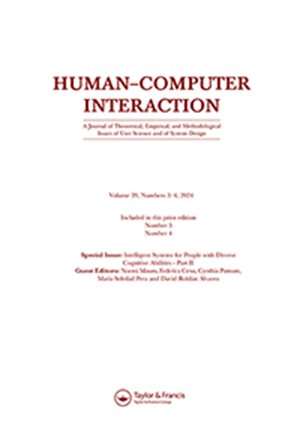Existential time and historicity in interaction design
IF 4.4
2区 工程技术
Q1 COMPUTER SCIENCE, CYBERNETICS
引用次数: 4
Abstract
Time is considered a defining factor for interaction design (Kolko, 2011; Löwgren, 2002; Malouf, 2007; Mazé, 2007; Smith, 2007), yet little is known about its history in this field. The history of time is non-linear and uneven, understood as part of each society’s cultural development (Friedman, 1990; Souza, 2016). As experienced by humans, time is socially constructed, using the available concepts, measurement devices, and technology in a specific culture. Since each human culture produces its own history, there are also multiple courses of time. The absolute, chronological, and standardized clock time is just one of them, yet one often imposed on other cultures through colonialism, imperialism, globalization, and other international relationships (Nanni, 2017; Rifkin, 2017). Digital technology is vital for this imposition, and interaction design has responsibility for it. As everyday life becomes increasingly mediated by digital technologies, their rhythms (Lefebvre, 2004) are formalized, structured, or replaced by algorithms that structure everyday life rhythms (a.ka. algorhythms) that offer little accountability and local autonomy (Finn, 2019; Firmino et al., 2018; Miyazaki, 2013; Pagallo, 2018). These algo-rhythms enforce absolute time over other courses of time as a means to pour modern values like progress, efficiency, and profit-making. Despite the appearance of universality, these values do have a local origin. They come from developed nations, where modernity and, more recently, neoliberalism were invented and dispatched to the rest of the world – as if they were the only viable modes of collective existence (Berardi, 2017; Harvey, 2007). Interaction design contributes to this dispatch by embedding – and hiding – modern and neoliberal values and modes of existence into digital technology’s temporal form (Bidwell et al., 2013; Lindley, 2015, 2018; Mazé, 2007). In the last 15 years, critical and speculative design research has questioned absolute time in interaction design (Huybrechts et al., 2017; Mazé, 2019; Nooney & Brain, 2019; Prado de O. Martins & Vieira de Oliveira, 2016). This research stream made the case that time can also be designed in relative terms: given a certain present, what are the possible pasts and futures? Looking at alternative futures (Bardzell, 2018; Coulton et al., 2016; Duggan et al., 2017; Linehan et al., 2014; Tanenbaum et al., 2016) or alternatives pasts (Coulton & Lindley, 2017; Eriksson & Pargman, 2018; Huybrechts et al., 2017) enables realizing alternative presents and alternative designs (Auger, 2013; Coulton et al., 2016; Dunne & Raby, 2013). These alternatives often include deviations from the (apparently) inevitable single-story future shaped by digital technologies envisioned by big tech companies. The deviation expands the design space – the scenarios considered in a design project (Van Amstel et al., 2016; Van Amstel & Garde, 2016) – to every kind of social activity, even the noncommercial. Dystopian what-if scenarios reveal undesirable modern futures that certain publics would oppose to (Dunne & Raby, 2013) whereas utopian how-might-we scenarios generate desirable local futures that communities may commit (Baumann et al., 2017; DiSalvo, 2014). Each community has different perceptions of time, requiring different ways of representing time,交互设计中的存在时间和历史性
时间被视为交互设计的决定性因素(Kolko, 2011;Lowgren, 2002;Malouf, 2007;迷宫,2007;Smith, 2007),但对其在这一领域的历史知之甚少。时间的历史是非线性和不平衡的,被理解为每个社会文化发展的一部分(Friedman, 1990;Souza, 2016)。正如人类所经历的那样,时间是社会建构的,使用特定文化中可用的概念、测量设备和技术。由于每一种人类文化都产生了自己的历史,所以也有多种时间进程。绝对的、按时间顺序的和标准化的时钟时间只是其中之一,但它经常通过殖民主义、帝国主义、全球化和其他国际关系强加给其他文化(Nanni, 2017;里夫金,2017)。数字技术在这一过程中起着至关重要的作用,交互设计对此负有责任。随着日常生活越来越多地受到数字技术的影响,它们的节奏(Lefebvre, 2004)被形式化、结构化或被结构化日常生活节奏的算法所取代。算法节奏)提供很少的问责制和地方自治(Finn, 2019;Firmino等人,2018;宫崎骏,2013;Pagallo, 2018)。这些算法节奏将绝对时间强加于其他时间进程之上,作为一种灌输进步、效率和盈利等现代价值观的手段。尽管表面上具有普遍性,但这些价值观确实有其地方性的根源。它们来自发达国家,在那里,现代性和最近的新自由主义被发明出来,并被派遣到世界其他地方——仿佛它们是集体存在的唯一可行模式(Berardi, 2017;哈维,2007)。交互设计通过将现代和新自由主义的价值观和存在模式嵌入并隐藏到数字技术的时间形式中,从而促进了这种分配(Bidwell等人,2013;Lindley, 2015, 2018;迷宫,2007)。在过去的15年里,批判性和投机性的设计研究质疑交互设计中的绝对时间(Huybrechts et al., 2017;迷宫,2019;Nooney & Brain, 2019;Prado de O. Martins & Vieira de Oliveira, 2016)。这一研究表明,时间也可以用相对术语来设计:给定一个特定的现在,可能的过去和未来是什么?展望未来(Bardzell, 2018;Coulton et al., 2016;Duggan et al., 2017;Linehan et al., 2014;Tanenbaum等人,2016)或替代过去(Coulton & Lindley, 2017;Eriksson & Pargman, 2018;Huybrechts等人,2017)能够实现替代礼物和替代设计(Auger, 2013;Coulton et al., 2016;Dunne & Raby, 2013)。这些替代方案往往与大型科技公司设想的数字技术塑造的(显然)不可避免的单层未来有所不同。偏差扩大了设计空间——设计项目中考虑的场景(Van Amstel等人,2016;Van Amstel & Garde, 2016)——对每一种社会活动,甚至是非商业性的。反乌托邦的“如果”情景揭示了某些公众会反对的不受欢迎的现代未来(Dunne & Raby, 2013),而乌托邦的“我们如何可能”情景产生了社区可能承诺的理想的地方未来(Baumann等人,2017;DiSalvo, 2014)。每个社区都有不同的时间观念,需要不同的方式来表示时间,
本文章由计算机程序翻译,如有差异,请以英文原文为准。
求助全文
约1分钟内获得全文
求助全文
来源期刊

Human-Computer Interaction
工程技术-计算机:控制论
CiteScore
12.20
自引率
3.80%
发文量
15
审稿时长
>12 weeks
期刊介绍:
Human-Computer Interaction (HCI) is a multidisciplinary journal defining and reporting
on fundamental research in human-computer interaction. The goal of HCI is to be a journal
of the highest quality that combines the best research and design work to extend our
understanding of human-computer interaction. The target audience is the research
community with an interest in both the scientific implications and practical relevance of
how interactive computer systems should be designed and how they are actually used. HCI is
concerned with the theoretical, empirical, and methodological issues of interaction science
and system design as it affects the user.
 求助内容:
求助内容: 应助结果提醒方式:
应助结果提醒方式:


